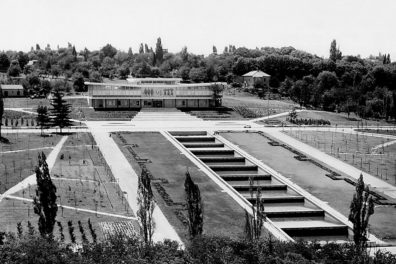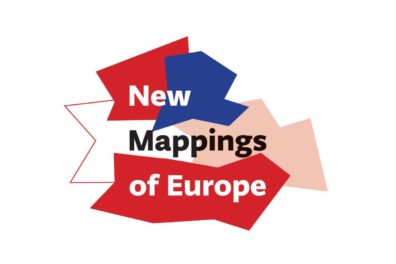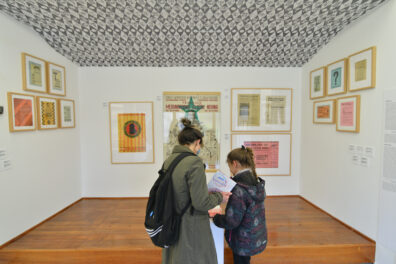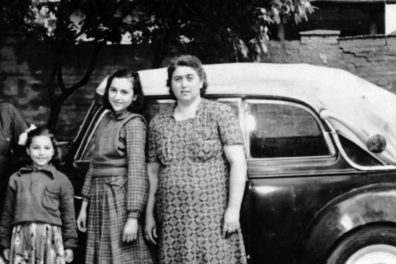
The Second World War on TV Screens – Notes by the Two Historians in Lockdown
What did elementary school students in Serbia and Montenegro, stuck in their homes, learn about the Second World War on the territory of Yugoslavia in the previous weeks? What would it be like to compare notes from online history classes from Belgrade and Cetinje? Who were the bearers of the anti-fascist resistance, and who cooperated with the enemy?
In the year when we mark a significant jubilee – seventy-five years since the end of the Second World War and the victory over fascism – there were no big ceremonies, military parades and gatherings, with the exception of Belarus. While in the previous weeks we sat locked in our homes, feverishly occupied with the spring cleaning, finally finding the time to clear the pantry or sort out the library, listening to the combat rhetoric expressions of the world statesmen who reiterated that the situation we found ourselves in those days was the biggest challenge the world faced since the end of the Second World War, some of us had the opportunity to see on school screens – on the public service, no less – a school example of the historical revisionism of that same war.
Better the war than the pact!
The event that was in the public spotlight was a history lesson in which a teacher called Milan Nedić a famous general from the First World War, great hero and important national figure, a man who saved refugees, tried to help and prevent the loss of the Serbian national body by calling on the people not to rise up against the enemy. That history lesson caught the attention of, among others, two historians, curators, colleagues and friends, stuck in their homes, one in Belgrade, and the other in Cetinje. Instead of devoting ourselves to our pantries, we decided to take a closer look at school desks in front of small screens in Serbia and Montenegro in order to point out some other key issues and, at the same time, to look at the attitude towards anti-fascist heritage, struggle, and the Second World War in these two countries, which emerged from the disintegration of socialist Yugoslavia, a state that was forged in that same war.
The story of the war begins with the accession of the Kingdom of Yugoslavia to the Triple Alliance by the Cvetković-Maček government. The reasons for this act were in the geopolitical position of Yugoslavia, since it was surrounded on all sides, except Greece, by the members of the pact. The events that followed – first the coup, and then the mass demonstrations on March 27 – were presented to the eight graders in Serbia in a very simplified, one-sided and essentially inaccurate manner. There were some foreign intelligence services that, on March 27, provoked demonstrations on the streets, led by the patriotic element in Yugoslavia and there were famous outbursts of patriotism – ‘Better the grave than a slave’; ‘Better the war than the pact’… Then, it led to the coup.
In Montenegro, on the other hand, these events were simply described as mass demonstrations of dissatisfied people from all parts of Yugoslavia, when in many cities children, women, adults, and the elderly shouted the famous slogans. Such inconsistent narratives only confirm something that is already well-known – to this day there have been many different interpretations of these events, from renunciation to glorification. However, despite the conflicting evaluations, subsequent appropriations by the CPY or the royalists, or attributing the March 27 exclusively to the British intelligence service, this date symbolizes the resolute anti-fascist commitment of various segments of Yugoslav society. It should also be taken into account that the demonstrations held on March 27 had an echo in the media around the world, as well as a moral incentive to resist fascism in the circumstances when the forces of the Triple Alliance occupied most of Europe. If we reduce March 27 exclusively to an act of patriotism or a result of the actions of foreign intelligence services, we in fact deny its essential anti-fascist character.
Who Fought for Which Yugoslavia?
One of the most controversial issues, when we talk about the Second World War in Yugoslavia, is the relationship between the partisan movement, led by Josip Broz Tito and the CPY, and the Chetnik movement of Dragoljub Draža Mihailović. In accordance with the changes that textbooks in Serbia have undergone in the last twenty years, a topic that Dubravka Stojanović dealt with extensively, those two movements were also presented as equal to the elementary school students in online classes. In addition, both movements fought for the restoration of the Yugoslav state, of course with an explanation that for the CPY this war was not only liberating but also revolutionary, which meant the creation of a new state, modelled on the Soviet, communist, system, in which the people would be owner of the production means. In contrast, the Chetnik movement advocated maintaining the Kingdom of Yugoslavia, where the Serbian national space would be specially demarcated… It would exist in a similar capitalist relationship as it was before the war. The teacher concluded that these differences made it impossible for the two movements to cooperate and led to their conflict. Particularly noticeable, primarily in the first five lessons, is the complete absence of the term anti-fascism, i.e. anti-fascist movements. Instead, terms such as libertarian movements or freedom-loving peoples were used. Such absence of clear ideological determinants creates space for relativization and different interpretations in which, after all, students in Serbia were not explicitly told that the Chetnik movement cooperated with the enemy, but without any explanation, in the summer of 1944 the Chetniks suddenly found themselves in the same trenches as German, Bulgarian and other Quisling units in the fight against the partisans and the Red Army, although it was previously said, insufficiently precisely, that the Yugoslav side had been recognized as a party in the war at the Tehran Conference. However, in one of the next lessons on the systematization of material, the teacher (there was a change of lecturer) introduced the term anti-fascist movements and methodologically went a step further by introducing the analysis of historical sources to the students. First, she compared the arrest warrants issued by the German occupation authorities for Broz and Mihailović, as a fundamental proof that these were two equal movements, since the German authorities also viewed them as such. These arrest warrants were among the most common arguments of revisionist historiography. However, they should be viewed in a broader context – they were issued in 1943 (which is not stated in the lecture), when the Allied invasion was expected and when it was necessary to provide a background from even the smallest unreliable elements. Furthermore, as an obvious indicator of the Chetnik anti-fascist orientation, the teacher confronted two sources before the students – a photo where the Chetniks are trampling the flag of the Third Reich and a document with the decisions of the II session of AVNOJ. The question inevitably arises why didn’t she opt for a written source instead of a photograph, such as a decision or order of the Chetnik movement? We can only assume that it would probably be far more problematic to put on the same level the decision to establish a “new Yugoslavia based on the national brotherhood and equality, as a common homeland of all its peoples” and the orders and decisions on ethnic cleansing and demarcation of Serbian ethnic space.
Contrary to “ideological confusion” or, in other words, silence in Serbia, in Montenegro, teachers use the term anti-fascism and even anti-communism during online lectures, in order to explain to their students the events and positions of the conflicting parties. Speaking about the Chetnik movement, they mention that Mihailović participated with his squad in the combat together with the partisans, but that it lasted only a few months and soon turned to the fight against the partisans while he waited for the defeat of the Germans on world fronts. It was further pointed out that the Chetnik movement did not deny the renewal of the Yugoslav state, but on the basis of Greater Serbia. The thesis is supported by instructions sent by Mihailović to the Chetnik commanders in Montenegro (December 20, 1941), Đorđe Lašić and Pavle Đurišić, on the cleansing of the state territory from national minorities and non-national elements, with an emphasis on the Muslim population. In addition, they paid special attention to the part about the creation of a greater Yugoslavia and Greater Serbia in it, with ethnically pure areas of Serbia, Montenegro, Bosnia and Herzegovina, Srem, Banat and Bačka. These claims were substantiated by reports of Montenegrin Chetnik raids on Muslim areas in Sandžak. Like their colleagues in Serbia, teachers from Montenegro also used photographs, but as a proof of the Chetnik movement’s cooperation with the occupiers and other collaborating forces.
A Forced or Organized Uprising Against Fascism?
We also paid attention to the narrative about the beginning of the uprising against the occupation authorities. Students in Serbia were presented with two parallel uprisings – the partisan uprising, conditioned by the German attack on the USSR, and the (cautious) Chetnik uprising, which was somewhat presented as forced, since the partisan units were the first to fight. Again, with the almost complete absence of ideological determinants. In contrast, there was a clear differentiation in Montenegro – in no uncertain terms they defined the narrative about the loan sharks, who fought for “independent and sovereign Montenegro”, but under the auspices of Italy. They did not commit crimes like the Montenegrin Chetniks; they refused to go to Bosnia to fight the partisans, and most of the members joined the People’s Liberation Movement after the capitulation of Italy. All of this could serve as a mitigating circumstance. However, to fulfil their goals, they used Italian help, which makes them collaborators. If there was revisionism in Montenegro, following the example of Serbia and the region, the loan sharks would have been portrayed as fighters for independence, and their cooperation with the Italians would have been diminished. Instead, a clear assessment was given that this was not the way in which Montenegro should have been rebuilt, and that’s why the emphasis was placed on the session in Jajce, according to which Montenegro regained its statehood. The loan sharks were even classified in the same rank as the Chetniks, who had aspirations to ethnically cleanse Montenegro. The 13 July Uprising was characterized as the beginning of the liberation war, and impressively called the first organized mass uprising against fascism on the territory of almost all of Europe. At the very end of the lecture, the teacher even pointed out to the students that our ancestors indebted us with these events… Although the 13 July Uprising was presented with a certain dose of bias and in superlatives, the lecturers from Montenegro still had a dose of criticism, as they introduced students to the “mistakes of the left”, i.e. partisan confrontation with dissidents in Montenegro in late 1941 and early 1942. Nevertheless, there was no dilemma among students in Montenegro about who, why, and in whose company was in the trenches, that is, which movement was not only liberating, but also anti-fascist.
Power or honour?
Finally, while we are on the subject of collaborationists, Montenegro had a negative attitude towards the Petrovdan Assembly, held on July 12, which declared “a sovereign and independent Montenegro”. The proclamation was further characterized as “alleged”, while the decision of Prince Mihailo Petrović Njegoš, who had rejected the Italian offer to be the king of Montenegro, was positively assessed and welcomed. As already mentioned, it remains unclear to the Serbian students how did the Chetniks find themselves in the trenches with the Germans, while Milan Nedić was presented as someone who first refused the offered honour to be the head of the government, but then reluctantly accepted this difficult task for the sake of a higher goal. As the teacher pointed out, he had an extremely difficult role of being the Prime Minister of Serbia, although he most likely knew that such cooperation with the enemy would inevitably lead to his downfall. The story of Milan Nedić, as the guardian of the Serbian national being, who accepted the burden of fate and the sacrifice to be remembered as a traitor in history, has been a mantra of historical revisionism in Serbia for many years, where collaboration is interpreted as conscious sacrifice in defence of the people. If, on the other hand, we look at Nedić’s proclamations and appeals to the deluded, in which he says: “War is raging in Europe. Communism is Europe’s mortal enemy, a terrible Asian disease that is still at its door. It has been trying to do this satanic job of its for two years. The fact that Europe is still alive, is due to the great German Reich that is defending European civilization in the East,” and “The greatest enemy of Serbs is communism; it should be exterminated from the Serbian people’s fields without mercy, until the end. Serbian armed units against the communists ought to be organized everywhere, with the help of Germany, and people should cooperate loyally with them all over the country.” The question inevitably arises – can anyone who openly calls for the extermination of compatriots from the liberation movement be considered a person who tried to prevent the loss of the Serbian national body?
These are just some of the questions and topics concerning the lessons about the Second World War on the small screen, which we discussed in numerous online gatherings and talks, locked at our homes in Belgrade and in Cetinje. Now, when we mark seventy-five years since the end of the war in Yugoslavia, and at the same time we can walk freely, we have decided to turn those conversations into text, in order to compensate for the untidy pantry and the fact that we did not master a new skill in lockdown, since we were dealing with some lessons from the past.

The Origins: The Background for Understanding the Museum of Yugoslavia
Creation of a European type of museum was affected by a number of practices and concepts of collecting, storing and usage of items.

New Mappings of Europe

Museum Laboratory
Starting from the Museum collection as the main source for researching social phenomena and historical moments important for understanding the experience of life in Yugoslavia, the exhibition examines the Yugoslav heritage and the institution of the Museum

